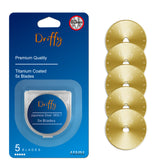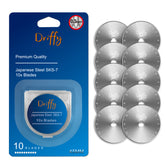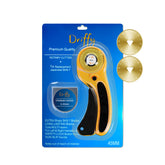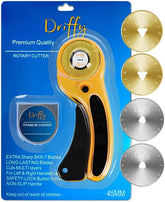Mastering Precision: The Ultimate Guide to Choosing and Using Rotary Cutters for Crafting Success
Unlock your crafting potential with the ultimate guide to mastering precision: choosing and using rotary cutters. Whether you're a seasoned artisan or just starting your creative journey, the right tools can make all the difference in achieving flawless results. Rotary cutters offer unparalleled precision for cutting fabrics, papers, and more, allowing you to tackle projects with confidence and ease.
In this comprehensive guide, we’ll explore the essential features of rotary cutters, from blade types to safety tips. You'll learn how to select the perfect cutter tailored to your crafting needs and discover techniques that enhance your efficiency and accuracy. Say goodbye to jagged edges and hello to seamless designs that elevate your crafting game. Whether you’re quilting, scrapbooking, or sewing, mastering these tools will empower you to transform your visions into reality. Let’s dive in and set the stage for crafting success!
Mastering Precision: The Ultimate Guide to Choosing and Using Rotary Cutters for Crafting Success
Unlock your crafting potential with the ultimate guide to mastering precision: choosing and using rotary cutters. Whether you're a seasoned artisan or just starting your creative journey, the right tools can make all the difference in achieving flawless results. Rotary cutters offer unparalleled precision for cutting fabrics, papers, and more, allowing you to tackle projects with confidence and ease.
In this comprehensive guide, we’ll explore the essential features of rotary cutters, from blade types to safety tips. You'll learn how to select the perfect cutter tailored to your crafting needs and discover techniques that enhance your efficiency and accuracy. Say goodbye to jagged edges and hello to seamless designs that elevate your crafting game. Whether you’re quilting, scrapbooking, or sewing, mastering these tools will empower you to transform your visions into reality. Let’s dive in and set the stage for crafting success!
Understanding the Anatomy of a Rotary Cutter
To choose the best rotary cutter for your needs, it's essential to understand its anatomy. A rotary cutter consists of several crucial parts, each playing a pivotal role in its functionality. The handle, often ergonomically designed, provides grip and control, ensuring smooth operation even during extended use. Handles can vary in size and shape, with some offering cushioned grips for added comfort, which is particularly beneficial for those with arthritis or hand fatigue.
The blade, the heart of the rotary cutter, is a circular, razor-sharp disc that rotates within the handle. Blades are available in various sizes, typically ranging from 18mm to 60mm in diameter. The size of the blade determines the type of cuts you can make; smaller blades are ideal for intricate, detailed work, while larger blades are suited for straight, long cuts. Additionally, the blade is often housed within a safety guard to prevent accidental cuts when not in use.
Another critical component is the blade lock mechanism, which secures the blade in place during use and allows for easy blade replacement. This feature is crucial for safety and ensures the blade doesn't wobble or shift, maintaining precise cuts. Understanding these components will help you make an informed decision when selecting a rotary cutter and using it effectively in your projects.
Types of Rotary Cutters: Which One is Right for You?
Rotary cutters come in various types, each designed to cater to different crafting needs. The most common type is the standard rotary cutter, which features a simple design with a straight handle and a circular blade. This type is versatile and suitable for a wide range of materials, making it a staple in any crafter's toolkit. Standard rotary cutters are perfect for cutting fabrics, papers, and other thin materials with ease and precision.
Another popular type is the ergonomic rotary cutter, designed with a curved handle that reduces hand strain and provides better control. These cutters are particularly beneficial for individuals who spend long hours cutting or those with hand issues like arthritis. The ergonomic design allows for a natural grip, reducing the risk of repetitive strain injuries. These cutters are ideal for quilters and sewists who need to make numerous cuts without sacrificing comfort.
For more specialized needs, you might consider a rotary cutter with a unique blade, such as a pinking blade, which cuts in a zigzag pattern to prevent fabric fraying. There are also wave and scallop blades for decorative edges, and perforating blades for creating dotted lines. Each type of blade offers different functionalities, allowing you to customize your cutting tool to your specific crafting requirements. By understanding the different types of rotary cutters available, you can select the one that best suits your projects and enhances your crafting experience.
Key Features to Look for in a Rotary Cutter
When selecting a rotary cutter, several key features can significantly impact its performance and usability. One of the most important features to consider is the blade size. Rotary cutter blades come in various sizes, with the most common being 28mm, 45mm, and 60mm. Smaller blades (18mm and 28mm) are ideal for intricate cuts and tight curves, while larger blades (45mm and 60mm) are better suited for cutting through multiple layers of fabric and making long, straight cuts. Choosing the right blade size for your projects will ensure precision and efficiency.
Another crucial feature is the handle design. Ergonomic handles are designed to reduce hand fatigue and provide a comfortable grip, which is essential for prolonged use. Some handles come with cushioned grips or contoured shapes to fit the natural curve of your hand, offering additional comfort and control. Adjustable handles that allow for different hand positions can also be beneficial, giving you the flexibility to switch grips and reduce strain.
Safety features should not be overlooked when choosing a rotary cutter. Look for cutters with a blade guard or cover that automatically retracts when not in use, preventing accidental cuts. Some rotary cutters also have a locking mechanism that secures the blade in place during use and storage. Additionally, consider cutters with easy blade replacement systems, as this will make maintenance more convenient and safe. By focusing on these key features, you can select a rotary cutter that meets your needs and ensures a smooth, enjoyable crafting experience.
Safety Tips for Using Rotary Cutters
Using a rotary cutter requires attention to safety to prevent accidents and injuries. One of the most important safety tips is to always engage the blade guard when the cutter is not in use. Many rotary cutters come with a safety lock or cover that protects the blade, and it's crucial to make sure this is in place before setting the cutter down. This simple step can prevent accidental cuts and keep both you and your workspace safe.
Another essential safety tip is to use a cutting mat specifically designed for rotary cutters. These mats are self-healing, meaning they can withstand repeated cuts without becoming damaged. Using a cutting mat protects your work surface and ensures that the blade remains sharp and effective. Additionally, cutting mats often have grid lines and measurements that help you make precise cuts, further enhancing safety and accuracy.
Proper hand positioning is also vital when using a rotary cutter. Always hold the cutter firmly with your dominant hand and keep your fingers away from the blade path. Use your other hand to hold the material in place, but make sure it's well clear of the cutting line. It's also a good practice to cut away from your body and keep the cutter perpendicular to the cutting surface. Following these safety tips will help you use your rotary cutter confidently and reduce the risk of accidents.
Best Practices for Maintaining Your Rotary Cutter
Maintaining your rotary cutter is essential for ensuring its longevity and performance. One of the best practices for maintenance is to regularly clean the blade. Over time, fabric fibers, dust, and adhesive residue can accumulate on the blade, affecting its sharpness and cutting ability. Use a soft cloth and a mild cleaning solution to wipe the blade clean, taking care to avoid direct contact with the sharp edge. Some crafters also recommend using a small brush to remove debris from hard-to-reach areas.
Another important maintenance tip is to periodically check and replace the blade. Even the highest-quality blades will dull over time, especially with frequent use. Signs that your blade needs replacing include difficulty cutting through materials, uneven or jagged edges, and increased pressure required to make cuts. Most rotary cutters have a simple mechanism for blade replacement, making it easy to switch out old blades for new ones. Keeping a supply of replacement blades on hand ensures you're always ready to tackle your projects.
Additionally, it's crucial to store your rotary cutter properly when not in use. Keep the cutter in a safe place, preferably with the blade guard engaged and the cutter stored in a protective case. This not only prevents accidental cuts but also protects the blade from damage. By following these best practices for maintaining your rotary cutter, you can ensure it remains in top condition and continues to deliver precise, clean cuts for all your crafting projects.
How to Choose the Right Blade for Your Projects
Choosing the right blade for your rotary cutter is essential for achieving the best results in your crafting projects. The type of blade you select should match the material you're cutting and the specific requirements of your project. The most common blade type is the standard straight blade, which is ideal for general-purpose cutting of fabrics, papers, and other thin materials. This blade provides clean, straight cuts and is a staple in any crafter's toolkit.
For more specialized needs, consider using a pinking blade. This blade cuts in a zigzag pattern, which helps prevent fabric fraying and adds a decorative edge to your cuts. Pinking blades are particularly useful for garment construction and quilting projects where fabric edges need extra reinforcement. Another option is the wave blade, which creates a wavy edge and is perfect for adding a decorative touch to scrapbook pages, cards, and other paper crafts.
Perforating blades are another useful option, especially for projects that require fold lines or tear-away sections. These blades create a series of small, evenly spaced cuts that allow the material to be easily folded or torn along the line. When selecting a blade, also consider the blade size. Smaller blades (18mm and 28mm) are ideal for detailed work and tight curves, while larger blades (45mm and 60mm) are better for cutting through multiple layers and making long, straight cuts. By choosing the right blade for your projects, you can ensure precise, professional results every time.
Techniques for Using Rotary Cutters Effectively
Mastering the techniques for using rotary cutters effectively can significantly enhance your crafting experience and improve the quality of your projects. One essential technique is to always use a cutting mat. Cutting mats provide a smooth, stable surface that protects your work area and helps maintain the sharpness of your blade. They also feature grid lines and measurements that aid in making precise cuts, ensuring accuracy in your projects.
When making cuts, it's crucial to use a ruler or straight edge to guide the rotary cutter. This helps achieve straight, clean lines and reduces the risk of the blade veering off course. For best results, use a clear acrylic ruler with measurement markings, which allows you to see the material beneath and align your cuts accurately. Hold the ruler firmly in place with one hand while using the other hand to guide the rotary cutter along the edge.
Applying consistent pressure is another key technique for effective cutting. Press the rotary cutter firmly but not excessively, allowing the blade to glide smoothly through the material. Too much pressure can cause the blade to wobble or the material to shift, resulting in uneven cuts. Practice makes perfect, so take your time to develop a steady hand and a feel for the right amount of pressure. By honing these techniques, you can achieve professional-level precision and efficiency in your crafting projects.
Common Mistakes to Avoid When Using Rotary Cutters
Even experienced crafters can make mistakes when using rotary cutters, but being aware of common pitfalls can help you avoid them and ensure better results. One common mistake is using a dull blade. A dull blade requires more pressure to cut and can lead to uneven, jagged edges. Regularly check the sharpness of your blade and replace it as needed to maintain clean, precise cuts.
Another frequent error is neglecting to use a cutting mat. Without a proper cutting mat, you risk damaging your work surface and dulling your blade more quickly. Cutting mats are designed to withstand repeated cuts and provide a stable, non-slip surface for your projects. Always use a cutting mat to protect both your workspace and your rotary cutter.
Improper hand positioning is another mistake to watch out for. It's essential to keep your fingers and hands clear of the blade path to prevent accidents. Always hold the cutter with a firm grip and use your other hand to stabilize the material, keeping it well away from the cutting line. Additionally, avoid cutting towards yourself, as this increases the risk of injury. By being mindful of these common mistakes and taking steps to avoid them, you can use your rotary cutter safely and effectively.
Conclusion: Elevate Your Crafting with the Right Rotary Cutter
Choosing and using the right rotary cutter can elevate your crafting projects to new heights of precision and professionalism. By understanding the anatomy of a rotary cutter and the different types available, you can select the tool that best suits your needs. Paying attention to key features such as blade size, handle design, and safety mechanisms ensures a cutter that is both effective and comfortable to use.
Safety is paramount when using rotary cutters, and following best practices can prevent accidents and extend the life of your tools. Regular maintenance, including cleaning and blade replacement, keeps your cutter in top condition. Selecting the appropriate blade for your specific projects further enhances your ability to achieve flawless results. Mastering effective techniques and avoiding common mistakes will empower you to tackle any crafting challenge with confidence.
Whether you're a quilter, scrapbooker, or sewing enthusiast, a high-quality rotary cutter is an indispensable tool in your crafting arsenal. Embrace the power of precision cutting and watch as your creations come to life with seamless edges and impeccable detail. By investing time in choosing the right rotary cutter and learning how to use it effectively, you set the stage for crafting success and unlock your full creative potential.












Leave a comment
Please note, comments need to be approved before they are published.